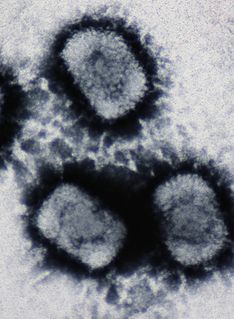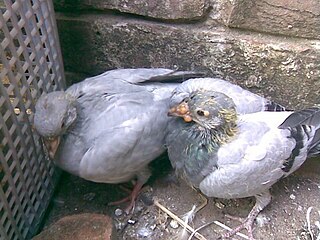
Cowpox is an infectious disease caused by the cowpox virus (CPXV). It presents with large blisters in the skin, a fever and swollen glands, typically following contact with an infected cow. The hands and face are most frequently affected and the spots are generally very painful.

Myxomatosis is a disease caused by Myxoma virus, a poxvirus in the genus Leporipoxvirus. The natural hosts are tapeti in South and Central America, and brush rabbits in North America. The myxoma virus causes only a mild disease in these species, but causes a severe and usually fatal disease in European rabbits. Myxomatosis is an excellent example of what occurs when a virus jumps from a species adapted to it to a naive host, and has been extensively studied for this reason. The virus was intentionally introduced in Australia, France, and Chile in the 1950s to control wild European rabbit populations.

Orf is a farmyard pox, a type of zoonosis. It causes small pustules in the skin of primarily sheep and goats, but can also occur on the hands of humans. A pale halo forms around a red centre. It may persist for several weeks before crusting and then either resolves or leaves a hard lump. There is usually only one lesion, but there may be many, and they are not painful. Sometimes there are swollen lymph glands.

A skin condition, also known as cutaneous condition, is any medical condition that affects the integumentary system—the organ system that encloses the body and includes skin, nails, and related muscle and glands. The major function of this system is as a barrier against the external environment.

Squirrelpox virus (SQPV) is a virus that causes the fatal disease squirrelpox in United Kingdom red squirrels. The virus is often carried by grey squirrels from North America, which rarely die from the disease. Elsewhere in the Red Squirrel's European range, either the grey squirrel does not occur or it lacks the poxvirus.
Phycomycosis is an uncommon condition of the gastrointestinal tract and skin most commonly found in dogs and horses. The condition is caused by a variety of molds and fungi, and individual forms include pythiosis, zygomycosis, and lagenidiosis. Pythiosis is the most common type and is caused by Pythium, a type of water mould. Zygomycosis can also be caused by two types of zygomycetes, Entomophthorales and Mucorales. The latter type of zygomycosis is also referred to as mucormycosis. Lagenidiosis is caused by a Lagenidium species, which like Pythium is a water mould. Since both pythiosis and lagenidiosis are caused by organisms from the class Oomycetes, they are sometimes collectively referred to as oomycosis.
Bovine alphaherpesvirus 2 (BoHV2) is a virus of the family Herpesviridae that causes two diseases in cattle, bovine mammillitis and pseudo-lumpy skin disease. BoHV2 is similar in structure to human herpes simplex virus.

Buffalopox is caused by buffalopox virus (BPXV); it is a Poxviridae for which the natural host is buffalo. It mainly infects buffalo but has been known to infect cows and humans. It is classified in the Orthopoxvirus (OPV) genus and the subfamily Chordopoxvirinae. The appearance of buffalopox follows a pattern and is described as emerging and re-emerging, it commonly occurs in sporadic and epidemic forms in domestic and commercial farm settings.
Ovine rinderpest, also commonly known as peste des petits ruminants (PPR), is a contagious disease primarily affecting goats and sheep; however, camels and wild small ruminants can also be affected. PPR is currently present in North, Central, West and East Africa, the Middle East, and South Asia. It is caused by small ruminants morbillivirus in the genus Morbillivirus, and is closely related to, among others, rinderpest morbillivirus, measles morbillivirus, and canine morbillivirus. The disease is highly contagious, and can have an 80–100% mortality rate in acute cases in an epizootic setting. The virus does not infect humans.

Sheeppox is a highly contagious disease of sheep caused by a poxvirus different from the benign orf. This virus is in the family Poxviridae and genus Capripoxvirus. Sheeppox virus (SPV) is the most severe of all the animal pox diseases and can result in some of the most significant economic consequences due to poor wool and leather quality.
Lumpy skin disease (LSD) is an infectious disease in cattle caused by a virus of the family Poxviridae, also known as Neethling virus. The disease is characterized by fever, enlarged superficial lymph nodes and multiple nodules on the skin and mucous membranes. Infected cattle also may develop edematous swelling in their limbs and exhibit lameness. The virus has important economic implications since affected animals tend to have permanent damage to their skin, lowering the commercial value of their hide. Additionally, the disease often results in chronic debility, reduced milk production, poor growth, infertility, abortion, and sometimes death.

Fowlpox is the worldwide disease of poultry caused by viruses of the family Poxviridae and the genus Avipoxvirus. The viruses causing fowlpox are distinct from one another but antigenically similar, possible hosts including chickens, turkeys, quail, canaries, pigeons, and many other species of birds. There are two forms of the disease. The first is spread by biting insects and wound contamination and causes lesions on the comb, wattles, and beak. Birds affected by this form usually recover within a few weeks. It can also be transmited via inhalation or ingestion of dust, or aerosols, leading to the ‘diphtheritic form’ of the disease, with lesions on the mucous membranes of the mouth, pharynx, larynx, and sometimes trachea. The second form is spread by inhalation of the virus and causes a diphtheritic membrane to form in the mouth, pharynx, larynx, and sometimes the trachea. The prognosis for this form is poor.

Canarypox virus (CNPV) is an Avipoxvirus and etiologic agent of canarypox, a disease of wild and captive birds that can cause significant losses. Canarypox can enter human cells, but it cannot survive and multiply in human cells. There is a live viral vaccine available which may have beneficial properties against human cancer when used as a mammalian expression vector.. Furthermore, the POXIMUNE® C vaccine does offer direct protection against CNPV in susceptible birds.
Rabbitpox is a disease of rabbits caused by a virus of the genus Orthopoxvirus in the family Poxviridae, and closely related to vaccinia virus. Rabbitpox was first isolated at the Rockefeller Institute in New York in 1933, following a series of epidemics in the laboratory rabbits. It is an acute disease only known to infect laboratory rabbits as no cases have been reported in wild rabbits; it also cannot infect humans.

Pigeon pox is a viral disease to which only pigeons are susceptible. It is characterized by pox scabs, which most frequently form on the featherless parts of the bird. The disease is caused by the Pigeon pox virus. It can be transmitted by droplet infection from one animal to another, or more commonly through infected insects or the digestion of contaminated food or water.
Milker's nodules are a cutaneous condition that is most commonly transmitted from the udders of infected cows. Milker's nodule is caused by Paravaccinia virus. The disease in humans is nearly identical to Orf.
Capripoxvirus is a genus of viruses in the subfamily Chordopoxvirinae and the family Poxviridae. Capripoxviruses are among the most serious of all animal poxviruses. All CaPV are notifiable diseases to the OIE. Sheep, goat, and cattle serve as natural hosts. These viruses cause negative economic consequences by damaging hides and wool and forcing the establishment of trade restrictions in response to an outbreak. The genus consists of three species: sheeppox virus (SPPV), goatpox virus (GTPV), and lumpy skin disease virus (LSDV). They share no serological relationship with camel pox, horse pox, or avian poxes. Capripoxviruses for sheeppox and goatpox infect only sheep and goat respectively. However, it is probable that North American relatives, the mountain goat and mountain sheep, may be susceptible to the strains but has not been experimentally proven. Lumpy skin disease virus affects primarily cattle, but studies have been shown that giraffes and impala are also susceptible to LSDV. Humans cannot be infected by Capripoxviruses.
Demodex bovis, also known as the cattle follicle mite, usually causes demodicosis, or demodectic mange, in cattle. This disease is common in tropical areas and is not usually found in temperate environments. Demodicosis is characterized by the formation of papules and nodules over the cattle's skin. These lesions most commonly occur on the neck, shoulders, and armpit of cattle; however, sometimes they also appear on the udder. This condition is often found in cattle with increased stress from pregnancy or lactation. Natural and acquired immunity can cause a decrease in the number of mites infesting a cow, as well as decreasing the severity of a cow's symptoms.
Phaeohyphomycosis is a diverse group of fungal infections, caused by dematiaceous fungi whose morphologic characteristics in tissue include hyphae, yeast-like cells, or a combination of these. It can be associated an array of melanistic filamentous fungi including Alternaria species,Exophiala jeanselmei, and Rhinocladiella mackenziei.
Pseudocowpox is a disease caused by the Paravaccinia virus or Pseudocowpox virus, a virus of the family Poxviridae and the genus Parapoxvirus. Humans can contract the virus from contact with livestock infected with Bovine papular stomatitis and the disease is common among ranchers, milkers, and veterinarians. Infection in humans will present with fever, fatigue, and lesion on the skin.









